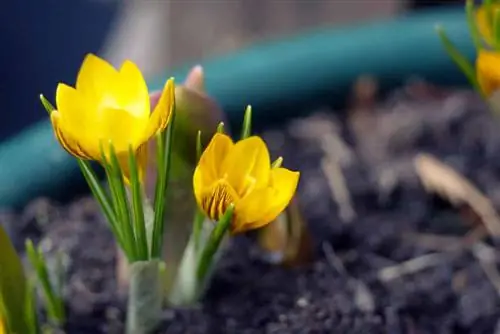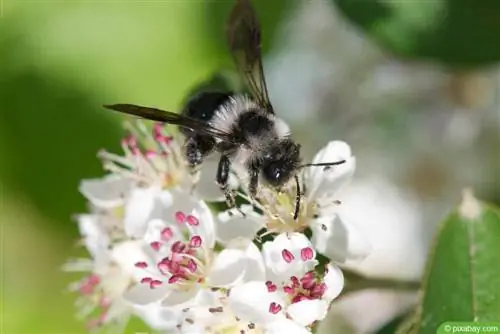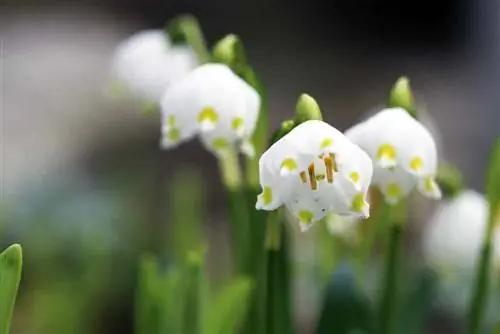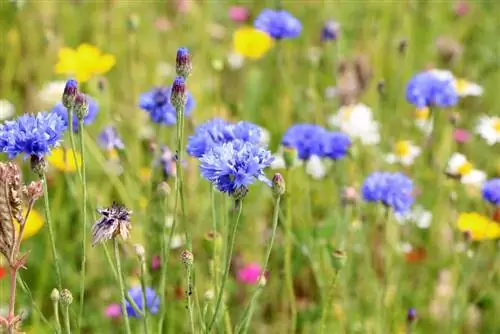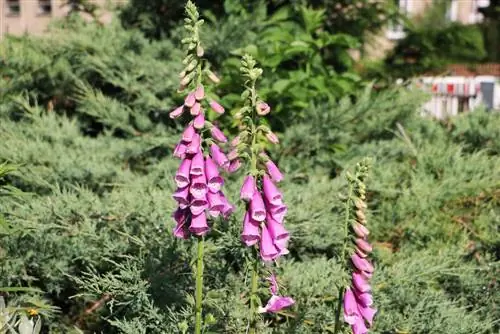- Author admin [email protected].
- Public 2023-12-17 03:39.
- Last modified 2025-10-04 22:41.
Not only in gardens, but also in forests and fields, wild, colorful early bloomers, the first harbingers of spring, bring nature back to life. They can be found in deciduous forests, meadows and floodplains.
Flowers in white
The first flowers appear in the forest and meadow in spring in an innocent white.
wood anemones
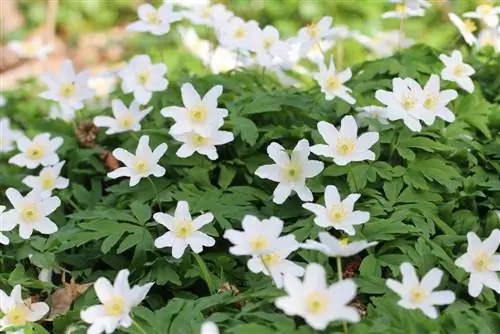
botanical name: Anemone nemorosa
Synonyms: Witch Flower
Height: 10 to 25 cm
Flowering time: March to April
Growth
- brownish, horizontal, underground creeping rhizomes
- slender, upright, bare stems
- Basal leaves irregularly toothed
- Stem leaves united in whorls to form 3 palmate leaves
Bloom
- Single flowers terminally on 2 to 3 cm long stems
- Diameter 2.5 to 3 cm
- Crown consisting of 6 to 12 elliptical crown petals
- Color whitish, sometimes slightly pinkish
Location:
- Deciduous and mixed forests
- Bushes and meadows
Special features: all parts of the plant are poisonous
Note:
A close relative is the yellow anemone (Anemone ranunculoides). The early bloomer can be found in alkaline deciduous forests and is also poisonous in all parts of the plant.
Hollow Larkspur
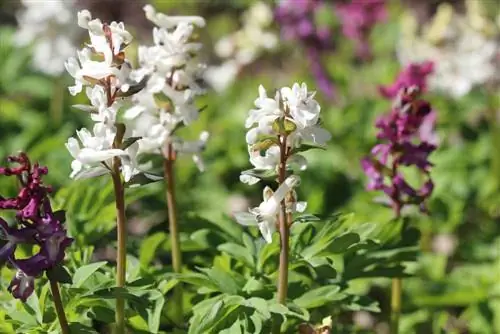
Botanical name: Corydalis cava
Height: 15 to 30 cm
Flowering time: March to May
Growth
- spherical, hollow 2 to 4 cm thick tuber
- upright growing, bare, unbranched stems
- double tripartite, blue-green tinted basal leaves
- Stem leaves smaller and pinnately split
Bloom
- terminal white flower cluster
- consisting of 5 to 20 individual flowers
- Bracters ovate and entire
- top of the two outer petals extended backwards to form a nectar-containing spur
- slightly widened at the front
Location
- Deciduous and riparian forests
- Bushes and orchards
Note:
These spring bloomers can also occur in colors red to purple.
Dog Tooth Lily
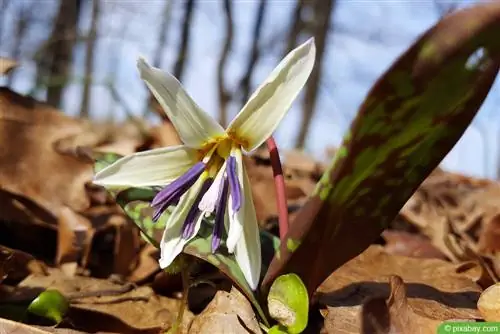
botanical name: Erythronium dens-canis
Height: 10 to 20 cm
Flowering time: March to April
Location: Deciduous forests
Growth
- oval onion
- from this arise 2 lanceolate to elliptical leaves
- 10 to 15 cm long and 3 to 4 cm wide
- greygreen
- Surface purple spotted
Bloom
- nodding single flowers
- consisting of lanceolate-curved petals
- in the middle 6 cm long stamens
Note:
These spring bloomers can also appear with pink flowers.
Märzenbecher
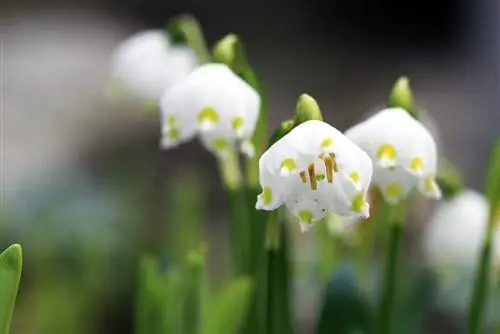
botanical name: Leucojum vernum
Synonyms: Spring knot flower
Height: 20 to 30 cm
Flowering time: February to March
Growth
- underground, roundish, whitish onion
- upright stems
- Leaves basal, narrow, slightly curled
- at the base encompassing the stem
Bloom
- nodding flowers singly or in pairs
- originate on a 3 to 4 cm long bract
- Petals 6 cm long
- whitish with yellow-green spots at the tip
Location
- light deciduous forests
- moist riparian forests
Special features: wild Märzenbecher are protected
Snowdrops
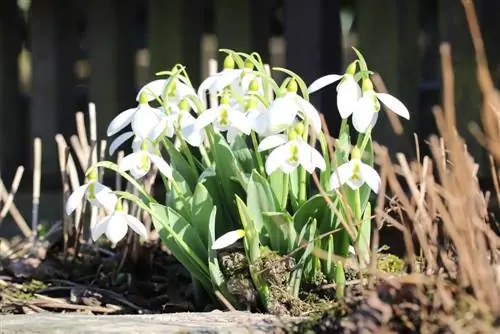
Botanical name: Galanthus nivalis
Height: 10 to 30 cm
Flowering time: February to March
Growth
- black-brown, underground onion
- long, upright stems; flat, linear sheets
- Length up to 20 cm
- standing in pairs
- Rounded tip
Bloom
- nodding single flower
- consisting of 3 larger outer petals and 3 smaller petals
- Petals two-lobed
- standing close together
- Flower white green spots at the bottom
Location
- Alluvial forests
- lean meadows
- light deciduous forests
Note:
Snowdrops are very common in gardens as early bloomers. However, in the wild they are protected.
White Daffodil
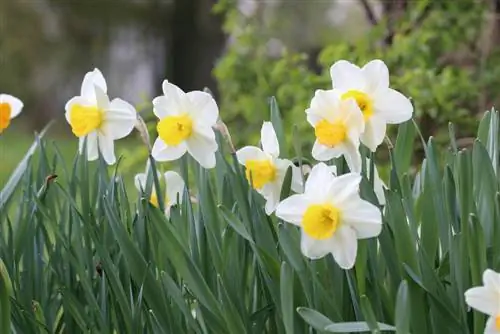
botanical name: Narcissus poeticus
Synonyms: Poet's Narcissus
Height: 20 to 30 cm
Flowering time: March to May
Growth
- underground oval bulb;
- upright, unbranched flower stems;
- brownish, membranous sheath at base;
- Leaves grass-like; usually 4 pieces per onion
- linear, grey-green
- becoming lighter towards the tip
Bloom
- long-stemmed single flowers
- 6 white, flatly spread petals
- Grown together into a flower tube
- Secondary crown yellow with reddish edge
- fragrant
Location
- Meadows and pastures
- Flat bogs
Special features
- are under nature conservation
- all parts of plants poisonous
Bright yellow flowers
The following early bloomers delight us with their sunny yellow.
Real cowslip
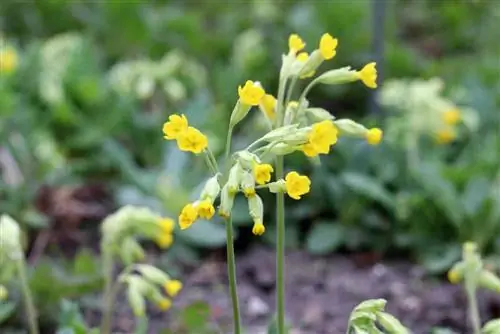
Botanical name: Primula veris
Synonyms: Cowslip, Cowslip
Height:15 to 30 cm
Flowering time: April to May
Growth
- robust, underground rhizomes
- upright growing
- Leaves standing together in a basal rosette
- oval, spatula-shaped
- Edge coarsely serrated
- Leaves on 5 to 8 cm long stems
- hairy on top
- Flower stems emerge from the center of the rosette
- longer than leaves
Bloom
- dense terminal umbel
- consisting of 5 to 15 flowers
- fragrant flowers on 1 to 2 cm long stems
- consisting of a calyx with oval triangular teeth
- funnel-like yellow crown with orange dotted throat
- Crown hem smooth or concave
Location
- Forest edges and bushes
- Meadows
- dry forests
Special features
- protected
- Use as a medicinal plant
Coltsfoot
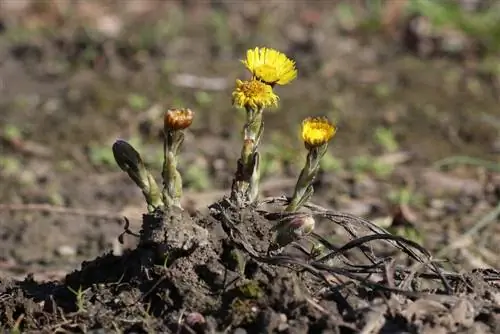
Botanical name: Tussilago farfara
Synonyms: Common Butterbur
Height: 10 to 30 cm
Flowering time: February to April
Growth
- horizontal creeping rhizome
- Development of leaves only after flowering
- Basal leaves on 4 to 7 cm long stems
- heart-shaped to roundish
- downy white hair underneath
- Edge coarsely serrated
- reddish stem leaves lanceolate and encircling the stem
- Stem upright
Bloom
- 2 to 3 cm wide flower heads
- single and terminal, medium-sized flowers tube-like, male sex
- Red flowers 12 to 18 mm long, female
Location
- Road and field edges
- wet meadows
- Rubbish sites
less celandine
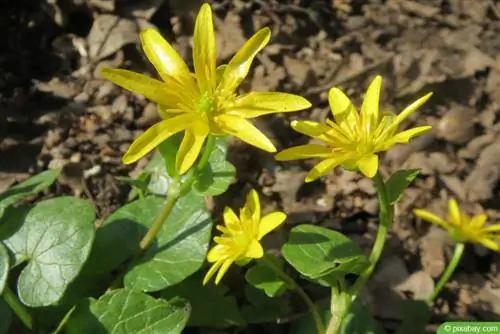
botanical name: Ranunculus ficaria
Synonyms: Feigwurz
Height: 6 to 18 cm
Flowering time: March to May
Growth
- underground, small, white, elongated root nodules
- bare prostrate or ascending stems
- green, shiny long-stemmed basal leaves
- round to heart-shaped
- Edge bluntly serrated
- Bulbulilli (brood buds) partly present in leaf axils
Bloom
- 2 cm wide individual flowers
- Calyx consisting of 3 to 4 sepals
- green- whitish colored
- Crown consisting of 8 to 11 egg-shaped, shiny petals
- Underside slightly brownish
Location
- moist deciduous and riparian forests
- wet parks and gardens
Special features: poisonous
Stemless primrose
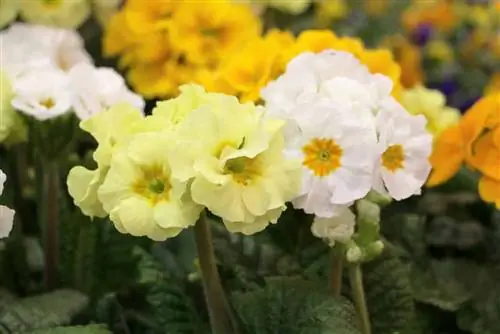
Botanical name: Primula vulgaris
Synonyms: Sleepless Primrose, Stemless Cowslip
Height: 5 to 15 cm
Flowering time: March
Growth
- herbaceous to bushy
- robust rhizome
- Leaves stand together in basic rosette
- inverted, elongated, ovoid
- Edge irregularly serrated
- when flowering 5 to 9 cm long
- bare on top
- Underside slightly downy hairy
- getting longer after flowering
Flower:
- developing from the center of the leaf rosette
- numerous sessile flowers
- sometimes 4 to 7 cm long, slightly woolly hairy stems possible
- Calyx forms 1 cm long tube
- pale yellow crown
Location
- Forests
- Meadows and bushes
Swamp Marigold
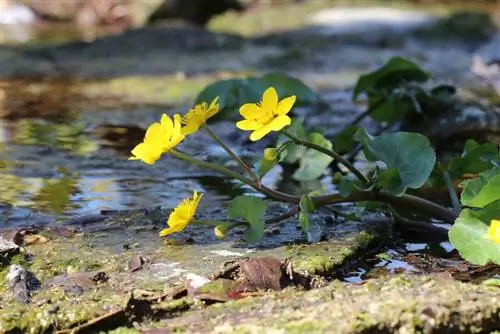
Botanical name: C altha palustris
Height: 15 to 40 cm
Flowering time: March to June
Growth
- thickened, rhizome-like roots
- upright, smooth, hollow stems
- Basal leaves on 5 to 20 cm hollow stems
- heart-shaped, circular or kidney-shaped
- Edge finely notched or serrated
- small, almost stalkless bracts
Bloom
- appears in 2 to 7 domineering groups
- stand at the top of the stems on 2 to 5 cm long stems
- Crown 2 to 4 cm wide, consisting of 5 to 8 golden yellow petals
- tinted green underneath
- no cup
Location
- Wet meadows and wet pastures
- Stream edges
- Alluvial forests
Special features: poisonous
Purple flowers enchant
The purple-flowering early bloomers appear mystical and captivate us with their beauty.
Spring Pasque Flower
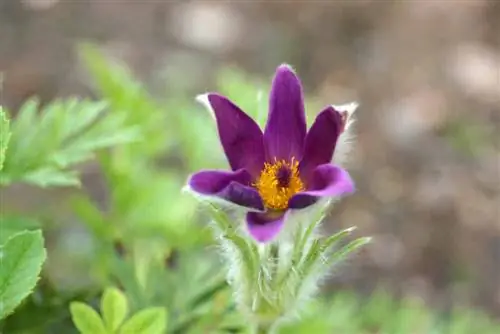
botanical name: Pulsatilla vernalis
Height: 10 to 30 cm
Flowering time: March to June
Growth
- persistent
- branched rhizome
- basal, simple pinnate leaves
- 3 hairy, fingered bracts
- standing alone
Bloom
- bell-shaped
- initially nodding, later standing up
- violet, whitish inside
Location
- Heiden
- Dry lawn
Special features
- rare and protected
- poisonous
- Use as medicine
Spring Crocus
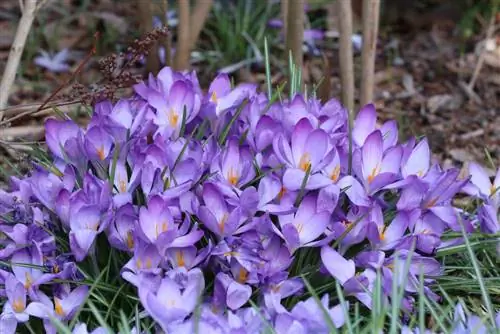
botanical name: Crocus albiflorus
Synonyms: White Saffron
Height: 10 to 15 cm
Flowering time: April to June
Locations: Meadows and wet pastures
Growth
- flat, spherical, net-fibrous tuber
- bottom leaves formed as a sheath
- Leaves appear at flowering time
- narrow, linear, dark green with white central stripe
Bloom
- mostly standing alone
- spatula-shaped
- 1, 5 to 2.5 cm long petals
- Grown together to form a tube at the base
- Pistil shorter than stamens
Note:
Very often the flower can also appear white.
liverwort
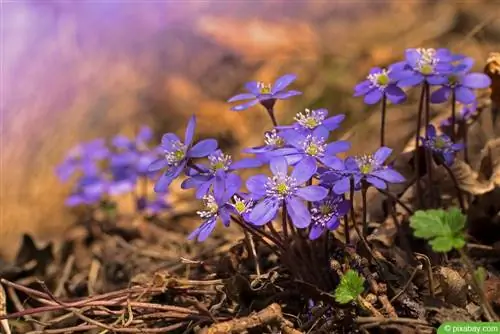
botanical name: Hepatica nobilis
Height: 5 to 15 cm
Flowering time: March to May
Growth
- persistent, brownish root network
- Leaves basal
- slightly leathery
- wintergreen
- stand on long stems
- three lobed with heart-shaped leaf base
- Top dark green
- violet underneath
- Stems growing directly from rhizome
- hairy
Bloom
- 1.5 to 2.5 cm wide
- 6 to 8 elliptical, rounded petals
Location
- Deciduous and coniferous forests
- Hedges
- prefer calcareous soils
Note:
The color of these spring bloomers can vary between purple, red, pink and white.
Smelling Violet

Botanical name: Viola odorata
Synonyms: March Violet
Height: 5 to 10 cm
Flowering time: March to April
Growth
- fine runners rooting above ground
- Leaves egg- to kidney-shaped
- Notched edge
- long-stemmed in basal rosette
Bloom
- 1 to 2.5 cm wide
- final
- strongly scented
- Calyx consisting of 5 oval sepals
- Crown consisting of 5 petals of unequal length
- Flower spur of the same color
- 6 mm long
Location
- Path and forest edges
- Meadows
- bushes
Special features
- Flowers only in the 2nd year
- white or pink flowers also possible
Dream in Blue
Like the bright blue sky in spring, these flowers also invite us to dream.
Lungwort
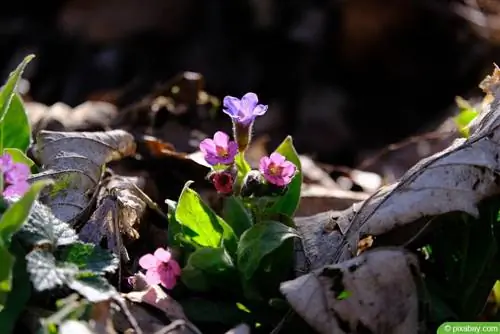
botanical name: Pulmonaria officinalis
Synonyms: Lungroot
Height: 20 to 30 cm
Flowering time: March to May
Growth
- Forming rhizome; herbaceous to bushy
- Leaves alternate
- heart-shaped to egg-shaped
- bristly-glandular hair with light spots
- Stems erect, rough hairy
Bloom
- bell-shaped, short-stemmed
- first red then blue
- appears in loose umbels
Location
- Mixed forests
- Bushes and roadsides
Special feature:
Used in folk medicine for various diseases of the lungs.
Star Hyacinth
Botanical name: Scilla bifolia
Synonyms: Two-leaf squill, squill
Height: 5 to 20 cm
Flowering time: March to May
Location: moist deciduous forests
Growth
- perennial, onion plant
- usually just a cylindrical flower stem
- 2 leaves surround stem at base
- but then far away; lanceolate
- 10 to 12 cm long; 1 to 1.5 cm wide
- Tip funnel-shaped
- often rolled edge
Bloom
- in loose 6 to 8-flowered clusters
- consist of 6 elongated elliptical tepals on a short stem

